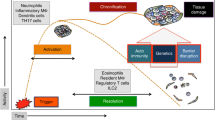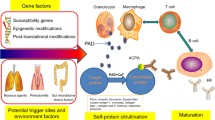Abstract
Rheumatoid arthritis is among the most frequent and severe chronic inflammatory diseases. The disease is characterized by ongoing synovial inflammation, which leads to the destruction of cartilage and bone. In RA, the mechanisms of resolution of inflammation, which are normally intact in the joints, are either suppressed or overruled. Little efforts have been undertaken to understand the mechanisms of resolution of arthritis until recently, when several molecular mechanisms have been identified that determine the chronicity and resolution of inflammation in the joints, respectively. This review describes the key concepts of resolution of arthritis mentioning the key mechanisms involved, such as regulatory macrophages, pro-resolving lipid, fatty acid and cytokine mediators, aggregated neutrophil extracellular trap formation, antibody glycosylation changes, and stromal cell alterations that are involved in determining the decision between chronicity and resolution of arthritis. Each of these mechanisms represents a potential therapeutic approach that allows skewing the balance of the inflammatory processes towards resolution.

Similar content being viewed by others
References
McInnes IB, Schett G (2011) The pathogenesis of rheumatoid arthritis. New Engl J Med 365:2205–2219
Schett G, Neurath MF (2018) Resolution of chronic inflammatory disease: universal and tissue-specific concepts. Nat Commun 9:3261
Culemann S, Grüneboom A, Nicolás-Ávila JÁ, Weidner D, Lämmle KF, Rothe T, Quintana JA, Kirchner P, Krljanac B, Eberhardt M, Ferrazzi F, Kretzschmar E, Schicht M, Fischer K, Gelse K, Faas M, Pfeifle R, Ackermann JA, Pachowsky M, Renner N, Simon D, Haseloff RF, Ekici AB, Bäuerle T, Blasig IE, Vera J, Voehringer D, Kleyer A, Paulsen F, Schett G, Hidalgo A, Krönke G (2019) Locally renewing resident synovial macrophages provide a protective barrier for the joint. Nature. 572:670–675
Serhan CN (2014) Pro-resolving lipid mediators are leads for resolution physiology. Nature 510:92–101
Levy BD, Clish CB, Schmidt B, Gronert K, Serhan CN (2001) Lipid mediator class switching during acute inflammation: signals in resolution. Nat Immunol 2:612–619
O'Neill LA (2015) A broken krebs cycle in macrophages. Immunity 42:393–394
Perretti M, Chiang N, La M, Fierro IM, Marullo S, Getting SJ, Solito E, Serhan CN (2002) Endogenous lipid- and peptide-derived anti-inflammatory pathways generated with glucocorticoid and aspirin treatment activate the lipoxin A4 receptor. Nat Med 8:1296–1302
Arnardottir HH, Dalli J, Norling LV, Colas RA, Peretti M, Serhan CN (2016) Resolvin D3 is dysregulated in arthritis and reduces arthritic inflammation. J Immunol 197:2362–2368
Schett G, Elewaut D, McInnes IB, Dayer JM, Neurath MF (2013) How cytokine networks fuel inflammation: toward a cytokine-based disease taxonomy. Nat Med 19:822–824
Rauber S, Luber M, Weber S, Maul L, Soare A, Wohlfahrt T, Lin NY, Dietel K, Bozec A, Herrmann M, Kaplan MH, Weigmann B, Zaiss MM, Fearon U, Veale DJ, Cañete JD, Distler O, Rivellese F, Pitzalis C, Neurath MF, McKenzie A, Wirtz S, Schett G, Distler JHW, Ramming A (2017) Resolution of inflammation by interleukin 9 producing type 2 innate lymphoid cells. Nat Med 23:938–944
Chen Z et al (2016) Th2 and eosinophil responses suppress inflammatory arthritis. Commun. 7:11596
Schauer C, Janko C, Munoz LE, Zhao Y, Kienhöfer D, Frey B, Lell M, Manger B, Rech J, Naschberger E, Holmdahl R, Krenn V, Harrer T, Jeremic I, Bilyy R, Schett G, Hoffmann M, Herrmann M (2014) Aggregated neutrophil extracellular traps limit inflammation by degrading cytokines and chemokines. Nat Med 20:511–517
Khandpur R, Carmona-Rivera C, Vivekanandan-Giri A, Gizinski A, Yalavarthi S, Knight JS, Friday S, Li S, Patel RM, Subramanian V, Thompson P, Chen P, Fox DA, Pennathur S, Kaplan MJ (2013) NETs are a source of citrullinated autoantigens and stimulate inflammatoryresponses in rheumatoid arthritis. Sci Transl Med 5:178ra40
Malmström V, Catrina AI, Klareskog L (2017) The immunopathogenesis of seropositive rheumatoid arthritis: from triggering to targeting. Nat Rev Immunol 17:60–75
Wunderlich C, Oliviera I, Figueiredo CP, Rech J, Schett G (2017) Effects of DMARDs on citrullinated peptide autoantibody levels in RA patients-a longitudinal analysis. Semin Arthritis Rheum 46(6):709–714
Nimmerjahn F, Ravetch JV (2007) The antiinflammatory activity of IgG: the intravenous IgG paradox. J Exp Med 204:11–15
Pfeifle R, Rothe T, Ipseiz N, Scherer HU, Culemann S, Harre U et al (2017) Regulation of autoantibody activity by the IL-23-TH17 axis determines the onset of autoimmune disease. Nat Immunol 18:104–113
Harre U, Lang SC, Pfeifle R, Rombouts Y, Fruhbeisser S, Amara K, Bang H, Lux A, Koeleman CA, Baum W et al (2015) Glycosylation of immunoglobulin G determines osteoclast differentiation and bone loss. Nat Commun 6:6651
Lucas S, Omata Y, Hofmann J, Böttcher M, Iljazovic A, Sarter K, Albrecht O, Schulz O, Krishnacoumar B, Krönke G, Herrmann M, Mougiakakos D, Strowig T, Schett G, Zaiss MM (2018) Short-chain fatty acids regulate systemic bone mass and protect from pathological bone loss. Nat Commun 9:55
Zaiss MM, Jones RM, Schett G, Pacifici R (2019) The gut-bone axis: how bacterial metabolites bridge the distance. J Clin Invest 129:3018–3028
Frank-Bertonceli M, Trenkmann M, Klein K, Karouzakis E, Rehrauer H, Bratus A, Kolling C et al (2017) Epigenetically-driven anatomical diversity of synovial fibroblasts guides joint-specific fibroblast functions. Nature Comm 8:14852
Croft AP, Campos J, Jansen K, Turner JD, Marshall J, Attar M, Savary L, Wehmeyer C, Naylor AJ, Kemble S, Begum J, Dürholz K, Perlman H, Barone F, McGettrick H, Fearon DT, Wei K, Raychaudhuri S, Korsunsky I, Brenner MB, Coles M, Sansom SN, Filer A, Buckley CD (2019) Distinct fibroblast subsets drive inflammation and damage in arthritis. Nature. 570:246–251
Author information
Authors and Affiliations
Corresponding author
Ethics declarations
Conflicts of interest
The author declares that there are no conflicts of interest
Additional information
Publisher’s note
Springer Nature remains neutral with regard to jurisdictional claims in published maps and institutional affiliations.
This article is a contribution to the special issue on Resolution of Inflammation in Chronic Diseases – Guest Editor: Markus Neurath
Rights and permissions
About this article
Cite this article
Schett, G. Resolution of inflammation in arthritis. Semin Immunopathol 41, 675–679 (2019). https://doi.org/10.1007/s00281-019-00768-x
Received:
Accepted:
Published:
Issue Date:
DOI: https://doi.org/10.1007/s00281-019-00768-x




